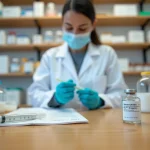Do you want to achieve optimal outcomes in managing your diabetes?
Are you curious about how GLP-1 medications can help you in your journey towards better health?
Well, you’ve come to the right place!
This article will explore the world of GLP-1 medications and provide valuable tips to ensure success in incorporating them into your treatment plan.
You may have heard about GLP-1 medications and wondered if they are the right fit for you. Well, let’s investigate the truth together! GLP-1 medications, or glucagon-like peptide-1 receptor agonists, work by mimicking the effects of a hormone called GLP-1 in your body. This hormone is crucial in regulating blood sugar levels and promoting insulin production. GLP-1 medications can enhance your body’s natural ability to control blood sugar and potentially achieve better glycemic control.
Key Takeaways
- Understand how GLP-1 medications work and their benefits in regulating blood sugar levels and promoting insulin production.
- Follow the healthcare provider’s instructions, communicate regularly, and monitor blood sugar levels to manage GLP-1 medications effectively.
- Be aware of potential side effects such as nausea, vomiting, and hypoglycemia and manage them according to the healthcare provider’s instructions.
- Maximize the benefits of GLP-1 medications by taking them as prescribed, adopting a healthy lifestyle, and regularly communicating with your healthcare provider for adjustments and overall health.
Understanding GLP-1 Medications
GLP-1 medications, like Victoza, are injectable drugs that work by mimicking the effects of a hormone called glucagon-like peptide-1, which helps to lower blood sugar levels and promote weight loss. These medications are a valuable tool in managing type 2 diabetes and achieving optimal outcomes for your health.
When you start taking a GLP-1 medication, it’s crucial to understand how it works and how to use it effectively. These medications are typically injected once a day or once a week, depending on the specific medication prescribed. It’s crucial to follow the instructions provided by your healthcare provider and take the medication as directed.
GLP-1 medications work by stimulating the release of insulin, decreasing the production of glucagon (a hormone that raises blood sugar levels), and slowing down the emptying of the stomach. This combination of actions helps to lower blood sugar levels and promote weight loss. By understanding how these medications work, you can better appreciate their potential benefits and be more motivated to incorporate them into your diabetes management plan.
Incorporating GLP-1 Medications into Your Treatment Plan
When incorporating GLP-1 medications into your treatment plan, it’s important to consider their potential benefits and how they can complement your current regimen.
GLP-1 medications, such as injectable drugs like Victoza or Trulicity, work by increasing the release of insulin, slowing down digestion, and reducing appetite. These medications can be a valuable addition to your treatment plan, helping to improve blood sugar control and potentially leading to weight loss.
Here are some tips to help you successfully incorporate GLP-1 medications into your routine:
- Talk to your healthcare provider: Before starting any new medication, it’s important to talk with your healthcare provider. They can provide information about the medicine, its potential benefits and side effects, and how it may fit into your overall treatment plan. They can also help you determine the appropriate dosage and medication schedule.
- Follow the prescribed regimen: Take GLP-1 medications as your healthcare provider prescribes. This may involve injecting the medication once a day or once a week, depending on the specific drug. Be sure to follow the instructions for proper storage and administration, and set reminders to help you remember to take your medication at the right time.
- Monitor your blood sugar levels: While taking GLP-1 medications, regularly monitor them to ensure they are within your target range. This will help you and your healthcare provider assess the effectiveness of the medication and make any necessary adjustments to your treatment plan. Record your blood sugar readings and share them with your healthcare provider during your regular check-ups.
Managing Side Effects and Potential Risks
You can take several steps to manage any potential side effects or risks. First, it’s important to follow the instructions provided by your healthcare provider closely. They will give you specific guidance on how to take your GLP-1 medication, including the dosage and timing. Sticking to this schedule is crucial to ensure the medication is effective and to minimize any potential side effects.
Additionally, be aware of the possible side effects that may occur with GLP-1 medications. Common side effects include nausea, vomiting, and diarrhea. If you experience any of these symptoms, let your healthcare provider know so they can guide how to manage them. They may recommend adjusting your dose or providing other medications to help alleviate these side effects.
To help you better understand the potential side effects and risks of GLP-1 medications, here is a table outlining some of the most common ones:
| Side Effect | Description |
|---|---|
| Nausea | A feeling of sickness in the stomach, often accompanied by the urge to vomit. |
| Vomiting | The act of forcefully expelling the contents of the stomach through the mouth. |
| Diarrhea | Frequent, loose, and watery bowel movements. |
| Hypoglycemia | Low blood sugar levels, which can cause symptoms such as dizziness, shakiness, and confusion. |
| Injection site reactions | Redness, swelling, or itching at the site of injection. |
Maximizing the Benefits of GLP-1 Medications
Make the most of your treatment by maximizing the benefits of these medications. GLP-1 medications have been proven to be effective in managing blood sugar levels and promoting weight loss in individuals with type 2 diabetes.
Firstly, make sure you’re taking your medication as your healthcare provider prescribes. Consistency is key when it comes to achieving optimal outcomes. Set a daily routine for taking your medicine and stick to it. This will help maintain steady blood sugar levels throughout the day and maximize the benefits of the medication.
In addition to taking your medication regularly, adopting a healthy lifestyle is vital. This includes following a balanced diet, engaging in regular physical activity, and managing stress levels. These lifestyle factors can greatly enhance the effectiveness of GLP-1 medications. A healthy diet can help regulate blood sugar levels and support weight loss, while exercise can improve insulin sensitivity and overall cardiovascular health.
By taking care of your overall well-being, you can maximize the benefits of your GLP-1 medication and achieve optimal outcomes.
Remember, your healthcare provider is your partner in managing your diabetes. Regularly communicate with them about your progress and any concerns or questions you may have. They can provide guidance and support to help you make the most of your treatment.
What Are Some Tips for Future Success with GLP-1 Medications?
When it comes to future success with GLP-1 medications, staying updated on the latest innovations in GLP1 medications is crucial. Keeping an eye on new developments in this field, such as new delivery methods or improved formulations, can help ensure optimal treatment outcomes for patients.
Monitoring and Adjusting Your Treatment with GLP-1 Medications
Monitoring and adjusting your treatment regimen with GLP-1 medications is crucial for ensuring the best results and managing your health effectively. By staying vigilant and attentive to your medication and its effects, you can take control of your health and achieve optimal outcomes.
Here are some important tips for monitoring and adjusting your treatment:
- Regularly check your blood sugar levels: Keeping track of your blood sugar levels is essential for understanding how your body responds to the medication. By monitoring your levels, you can identify any patterns or trends and make necessary adjustments to your treatment plan.
- Pay attention to your body: Your body is unique, and it may respond differently to GLP-1 medications than others. Be in tune with how you feel and to report any changes or concerns to your healthcare provider. They can help you make any necessary adjustments to your medication or dosage.
- Keep a log of your meals and physical activity: Tracking your meals and physical activity can provide valuable insights into how your lifestyle choices impact your blood sugar levels. By keeping a log, you can identify any patterns or triggers that may affect your response to GLP-1 medications.
- Regularly communicate with your healthcare provider: Open and honest communication with your healthcare provider is key to successful treatment. They can guide you in monitoring your progress, adjusting your medication, and addressing any concerns or questions. Remember, they’re here to support you in achieving the best possible outcomes.
Frequently Asked Questions
Can GLP-1 medications be used in combination with other diabetes medications?
Yes, you can use GLP-1 medications in combination with other diabetes medications. Working together can help you achieve optimal outcomes in managing your diabetes and improving your overall health.
How long does it take for GLP-1 medications to start working?
GLP-1 medications typically start working within a few days. It’s like planting and watching a seed sprout into a beautiful flower. Stay patient and committed, and soon you’ll see the positive effects.
Are GLP-1 medications suitable for pregnant women with diabetes?
GLP-1 medications may not be suitable for pregnant women with diabetes. Consult with your healthcare provider to determine the best treatment option that ensures your and your baby’s health.
What should I do if I forget to take a dose of my GLP-1 medication?
If you forget a dose of your GLP-1 medication, don’t panic. Simply take the missed dose as soon as you remember, unless it’s almost time for your next one. Remembering to take it is like a key to unlocking your health potential.
Can GLP-1 medications be used for weight loss in individuals without diabetes?
Yes, GLP-1 medications can be used for weight loss in individuals without diabetes. They work by reducing appetite and increasing feelings of fullness. Talk to your doctor to see if they’re right for you.

















